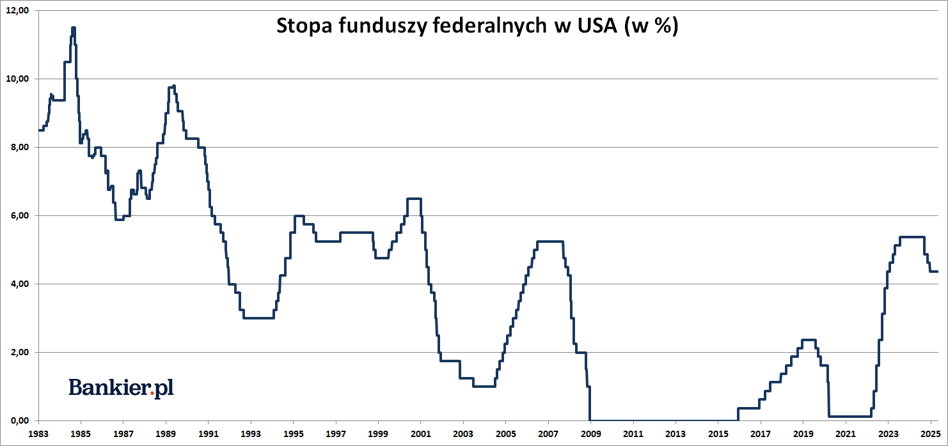Fed extends cut pause. Rates remain unchanged again

Federal Open Market Committee (FOMC) did not change the level of interest rates, which was in line with market expectations and analysts. However, investors expect that the pause in monetary policy easing will end in the summer.
The federal funds rate range remained unchanged at 4.25-4.50% - the Federal Open Market Committee (FOMC) announced in a statement. May the decision was made unanimously and was in line with the expectations of economists and market participants.


- Although fluctuations in net exports had an impact on the data, recent indicators suggest that economic activity continues to grow at a solid pace The unemployment rate has stabilized at a low level in recent months. level, and labor market conditions remain strong. Inflation remains slightly elevated – we read in the May FOMC statement.
- The Committee is sensitive to risks for both sides of its double mandate and believes that the risk of higher unemployment and higher inflation – this is a rather unusual sentence for a statement from central bankers. It is, in a way, an admission of helplessness in response to such a shock. for the US economy may be President Trump's tariff policy.
– Uncertainty about the economic outlook still increased more , the Committee noted.
Also in In May, the FOMC did not change the level of interest rates, but decided to limiting the "quantitative tightening" (QT) of monetary policy. Starting Since April, the Federal Reserve has slowed the pace of its balance sheet reduction from USD 60 billion to USD 40 billion per month.
Post-election "pause" in monetary easing- We don't have to hurry and we are well prepared, to wait for more clarity (on the Trump administration's policies – (editor's note) – he said On March 7, the head of the US central bank.
Also in January it was decided decision to keep the federal funds rate range unchanged level. Previously, at each of the three previous meetings, the Committee had taken decisions to cut the federal funds rate. In September, it was decided to start a cycle of loosening monetary policy with a rate cut of as much as 50 basis points at once .
That decision was quite controversial because only in In 2001 and 2007, the Federal Reserve began its rate cut cycle with such a large cuts. The narration also sounded not very convincing Chairman Powell talking about “recalibrating” monetary policy . In In November, a second reduction was made, but this time by the "standard" 25 basis points . Also by 25 basis points. US rates were cut in December . The total scale of last year's cuts therefore amounted to 100 bp.
The futures market estimates the chances at 73% that at least A 25 basis point cut in the federal funds rate will come in June or July FOMC meeting – according to FedWatch Tool calculations. By the end of 2025 A total rate cut by the Fed of 75-100 basis points is estimated for the year. This is more than suggested the March arrangement of "fedoklotki", where the majority of votes were drawn only for a 50 basis point cut in rates by the end of this year.
- The Committee is strongly committed to supporting the mandate full employment and bring inflation back to the 2 percent target – the Federal Open Market Committee recalled in its May statement.
The next meeting of the Federal Open Market Committee is scheduled for June 17-18.
Powell: Time will tell how economy responds to tariffs- Despite the increased uncertainty, the economy is still in solid position. The unemployment rate remains low and the labor market is in a good position almost full employment. Inflation has fallen significantly but remains slightly above our 2 percent long-term target, the Federal Reserve chairman said Jerome Powell outlined the state of the economy during a May press conference.
- Household and business surveys have shown that a sharp decline in sentiment and heightened economic uncertainty, mainly reflecting concerns about customs policy. Time will tell how these events could affect future consumer and investment spending – Chairman Powell noted.
The Fed chairman noted that the increase in customs tariffs would probably will generate an increase in inflation and a slowdown in economic growth. – Inflationary effects may be short-lived, reflecting a one-time change in the price level. It is But it is also possible that the inflationary effects will be more persistent, Powell noted.
- We may find ourselves in a difficult situation where the goals our dual mandate will be at risk , the Federal Reserve chairman warned. “ We are in a good position to wait and see what happens will happen - Jerome Powell reassured. He also added that the situation in general inflation is under control and that the US central bank does not need to rush into your decisions.
Powell has repeatedly said the Fed needs to be "patient" and that he can calmly wait for the situation to develop. Only when the situation is known consequences for the economy, he will be able to take action. The Fed chief will not He did not specify when such a state could be achieved. He spoke a lot about the uncertainty related to customs policy and trade negotiations.
bankier.pl






